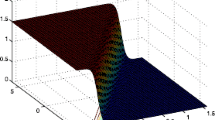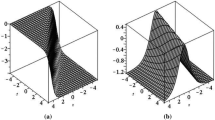Abstract
In this article, an initial and boundary value problem for variable coefficients coupled KdV–Burgers equation is considered. With the help of Lie group approach, initial and boundary value problem for variable coefficients coupled KdV–Burgers equation reduced to an initial value problem for nonlinear third-order ordinary differential equations (ODEs). Moreover, the systems of ODEs are solved to obtain soliton solutions. Further, classical fourth-order Runge–Kutta method is applied to systems of ODEs for constructing numerical solutions of coupled KdV–Burgers equation. Numerical solutions are computed, and accuracy of numerical scheme is assessed by applying the scheme half mesh principal to calculate maximum errors.






Similar content being viewed by others
References
Su, C.H., Gardner, C.S.: Drivation of the Korteweg–de Vries and Burgers equation. J. Math. Phys. 10, 536–539 (1969)
Wijngaarden, L.V.: On the motion of gas bubbles in a perfect fluid. Annu. Rev. Fluid Mech. 4, 369–373 (1972)
Johnson, R.S.: Shallow water waves on a viscous fluid—the undular bore. Phys. Fluids 15, 1693–1699 (1972)
Hu, P.N.: Collisional theory of shock and nonlinear waves in a plasma. Phys. Fluids 15, 854–864 (1972)
Korteweg, D.J., Vries, G.: On the change of form of long waves advancing in a rectangular canal, and on a new type of long stationary waves. Philos. Mag. 39, 422–443 (1895)
Burgers, J.M.: A Mathematical Model Illustrating the Theory of Turbulence. Academic Press, New York (1948)
Feudel, F., Steudel, H.: Nonexistence of prolongation structure for the Korteweg–de Vries–Burgers equation. Phys. Lett. A 107, 5–8 (1985)
Johnson, R.S.: A nonlinear equation incorporating damping and dispersion. J. Fluid Mech. 42, 49–60 (1970)
Grad, H., Hu, P.N.: Unied shock prole in a plasma. Phys. Fluids 10, 2596–2602 (1967)
Canosa, J., Gazdag, J.: The Korteweg–de Vries–Burgers equation. J. Comput. Phys. 23, 393–403 (1977)
Dauletiyarov, K.Z.: Investigation of the dierence method for the Bona–Smith and Burgers–Korteweg–deVries equations. Zh. Vychisl. Mat. i. Mat. Fiz. 24, 383–402 (1984)
Avilov, V.V., Krichever, I.M., Novikov, S.P.: Evolution of the Whiteham zone in the Korteweg–de Vries theory. Soviet. Phys. Dokl. 32, 345–349 (1987)
Bona, J.L., Schonbek, M.E.: Traveling wave solutions to Korteweg–de Vries–Burgers equation. Proc. R. Soc. Edinb. 101, 207–226 (1985)
Guan, K.Y., Gao, G.: The qualitative theory of the mixed Korteweg–de Vries–Burgers equation. Sci. Sin. Ser. A 30, 64–73 (1987)
Guan, K.Y., Lei, J.Z.: Integrability of second order antonomous system. Ann. Differ. Equ. 10, 117–135 (2002)
Gao, J.X., Lei, J.Z., Guan, K.Y.: Integrable condition on traveling wave solutions of Burgers–KdV equation. J. North. Jiaotong Univ. 27, 38–42 (2003)
Shu, J.J.: The proper analytical solution of the Korteweg–de Vries equation. J. Phys. A Math. Gen. 20, 49–56 (1987)
Drazin, P., Johnson, R.: Solitons: An Introduction. Cambridge Univesity Press, New York (1989)
Shaojie, Y., Cuncai, H.: Lie symmetry reductions and exact solutions of a coupled KdV–Burgers equation. Appl. Math. Comput. 234, 579–583 (2014)
Ovsiannikov, L.V.: Group Analysis of Differential Equations. Academic Press, New York (1982)
Bluman, G.W., Kumei, S.: Symmetries and Differential Equations. Springer, New York (1989)
Olver, P.J.: Applications of Lie Groups to Differential Equations. Springer, New York (1993)
Chou, T.: Lie Group and Its Applications in Differential Equations. Science Press, Beijing (2001)
Kaur, L., Gupta, R.K.: Kawahara equation and modified Kawahara equation with time dependent coefficients: symmetry analysis and generalized \(\left( {{G}^{\prime }/G} \right)\)-expansion method. Math. Methods Appl. Sci. 36, 584–601 (2013)
Kumar, V., Gupta, R.K., Jiwari, R.: Comparative study of travelling wave and numerical solutions for the coupled short pulse (CSP) equation. Chin. Phys. B 22, 050201 (2013)
Johnpillai, A.G., Kara, A.H., Biswas, A.: Symmetry reduction, exact group-invariant solutions and conservation laws of the Benjamin–Bona–Mahoney equation. Appl. Math. Lett. 26, 376–381 (2013)
Kumar, V., Gupta, R.K., Jiwari, R.: Painlevé analysis, Lie symmetries and exact solutions for variable coefficients Benjamin–Bona–Mahony–Burger (BBMB) equation. Commun. Theor. Phys. 60, 175–182 (2013)
Gupta, R.K., Kumar, V., Jiwari, R.: Exact and numerical solutions of coupled Short Pulse equation with time-dependent coefficients. Nonlinear Dyn. 79, 455–464 (2014)
Singh, M., Gupta, R.K.: Exact solutions for nonlinear evolution equations using novel test function. Nonlinear Dyn. 86, 1171–1182 (2016)
Singla, K., Gupta, R.K.: On invariant analysis of some time fractional nonlinear systems of partial differential equations. J. Math. Phys. 57, 101504–14 (2016)
Rai, P., Sharma, K.K.: Parameter uniform numerical method for singularly perturbed differential–difference equations with interior layer. Int. J. Comput. Math. 88, 3416–3435 (2011)
Rai, P., Sharma, K.K.: Numerical analysis of singularly perturbed delay differential turning point problem. Appl. Math. Comput. 218, 3483–3498 (2011)
Acknowledgements
The authors would like to thank the Deanship of Scientific Research at Princess Nourah bint Abdulrahman University for supporting this research.
Author information
Authors and Affiliations
Corresponding author
Appendix
Appendix
At the present appendix, we find the connection between the methods used in this paper to find the exact and numerical solutions. We compared the exact solutions obtained in Sect. 3 under the subalgebra 3.1, with the numerical solution by using the numerical technique RK4 method used in Sect. 4. The acquiring of the whole computational work is done with the help of the absolute errors \(E_a \), relative error \(E_{ r}\) and percentage error \(E_{ p} \) given by the following formulas
where u and \(\bar{{u}}\) denote the exact and numerical solution of the problem.
For numerical solution, we start with initial values at \(\xi = 1,\) with the restriction on the arbitrary constants of ODEs (3.1) as \(K_1 = 0, K_2 = \frac{1}{8 }, K_3 = \frac{3 K_5 }{2 K_2 }, K_4 = 0, \lambda _1 = -\frac{1}{2}, \lambda _2 = -2\) and initial approximation by solutions (3.3) with the restrictions on the arbitrary constants as \(a_1 = b_1 = -8 K_2 .\) Then, the reduced ODEs system (3.1) for KdV–Burgers equation transforms into the following initial value problem (IVP)
with initial conditions
In that case, the comparison between exact and numerical solution with respect to IVP (5.1–5.2) is depicted below with the help of Fig. 6. Also, acquiring of the computational work is presented here with the help of Table 9. Form these results, we conclude that the numerical solutions are in good agreement with the exact solution. The results reported here provide further evidence of the usefulness of the fourth-order Runge–Kutta method for solving nonlinear equations.
Rights and permissions
About this article
Cite this article
Kumar, V., Alqahtani, A. Lie symmetry analysis, soliton and numerical solutions of boundary value problem for variable coefficients coupled KdV–Burgers equation. Nonlinear Dyn 90, 2903–2915 (2017). https://doi.org/10.1007/s11071-017-3851-0
Received:
Accepted:
Published:
Issue Date:
DOI: https://doi.org/10.1007/s11071-017-3851-0




